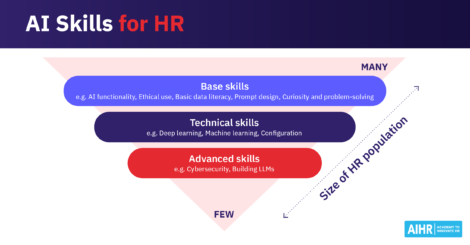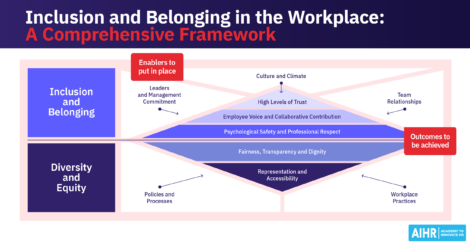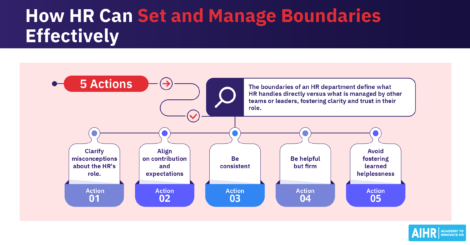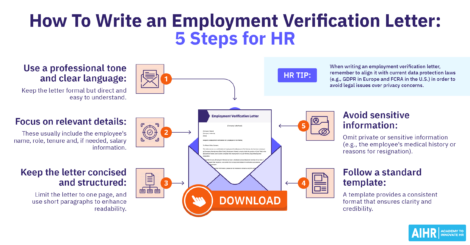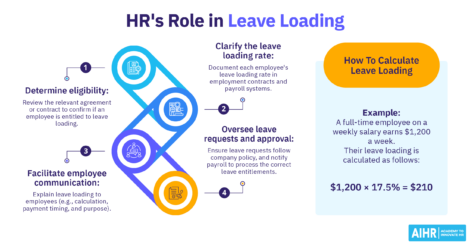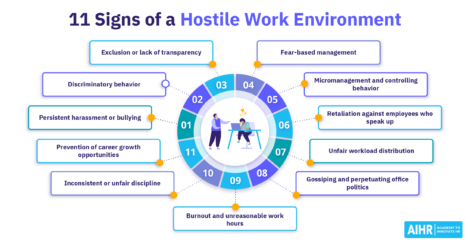4 Innovative Performance Management Approaches To Implement
What comes to mind when you think about performance management? For many, it’s tedious processes, unfair ratings, and frustrating conversations. Unsurprisingly, performance management is often regarded as a necessary evil. However, it doesn’t have to be.

Remarkably, while organizations that prioritize their employees’ performance are 4.2 times more likely to outperform their peers, only 2% of CHROs consider their performance management system effective. Over 80% of HR professionals are working to change the performance management approach at their organization, yet stories of success remain few and far between.
So, what’s the solution to this dilemma? Should we abandon performance management altogether?
In this article, we evaluate why performance management remains essential for business success, argue that current approaches are not suitable for all organizations, and show four innovative performance management approaches.
Contents
Do we still need performance management?
4 future-ready performance management approaches
1. The Retro Reflection Method
2. Client-Colleague-Manager Feedback Method
3. Mission-Based OKR Method
4. Continuous Dialogue Method
How to start innovating your performance management
Do we still need performance management?
When done correctly, performance management remains a critical process for aligning business objectives with employee development. The problem is that many performance management approaches are based on outdated principles designed for more predictable, repetitive work environments.
In the fast-paced world of work of today, where roles change and goals shift rapidly, performance management must evolve too. New approaches are required—ones that reflect the way work happens now.
Traditionally, performance management followed a structured process. Managers would set specific goals for employees, often aligning them with company objectives through a top-down approach known as goal cascading.
Throughout the year, managers would provide feedback, measure performance, and calibrate ratings to ensure consistency across teams. At the end of the cycle, these evaluations would be finalized, usually influencing decisions about promotions, raises, or development plans.
This method works well in organizations that meet the following five criteria:
- There is a clear organizational structure, with accountability and goals defined at each level. In an organization like this, it’s easy to understand how each team member contributes to the manager’s goals.
- The organization runs on an annual cycle, with plans set for each year. For example, there is a plan in place with targets, and goals are evaluated annually.
- A traditional method works in organizations that can easily link successful output to performance impact. For example, call center agents can be assessed by the number of queries they resolve or sales consultants by the amount of products they sell.
- The organization has clear roles and responsibilities that define each individual’s contributions to organizational success. That means job descriptions or other statements of work for all roles.
- The organization uses precise rating scales describing work output at each level to quantify success. For example, a sales consultant must know that hitting 100% of their sales target is a 3, or a “meet expectations” rating, while 120% is a 5, or exceptional performance.
However, in today’s agile, fast-moving organizations, these assumptions no longer hold for all types of business. Many employees work across projects, collaborate with multiple teams, and juggle rapidly shifting priorities. Traditional performance management methods fail to account for the fluidity of modern work and the complexity of measuring success in such environments.
This is where alternative performance management methods come into play, offering more flexibility and a better fit for modern work demands.
Megan Bickle, Fractional Talent Management Strategist and top voice on performance management on LinkedIn notes that Microsoft had four different approaches to performance management, each with varying levels of flexibility and accountability.
In Europe, where work councils enforce stricter standards, Microsoft adopted a broader philosophy focused on how they want employees to feel, emphasizing a growth mindset. This mindset is reflected in the company’s culture, learning processes, and the conversations leaders have with their teams. The approach also allows for flexibility across different countries or business functions, ensuring alignment while adapting to local or functional needs.
4 future-ready performance management approaches
Modern performance management methods can be mapped across two key dimensions: flexibility vs. structure and internal vs. external focus.
- Flexible vs. structured: Flexible methods are adaptable and can be applied anytime, while structured methods follow a defined sequence with clear steps.
- Internal vs. external focus: Internal methods focus on the impact within the organization, while external methods emphasize outcomes that affect clients or external stakeholders.
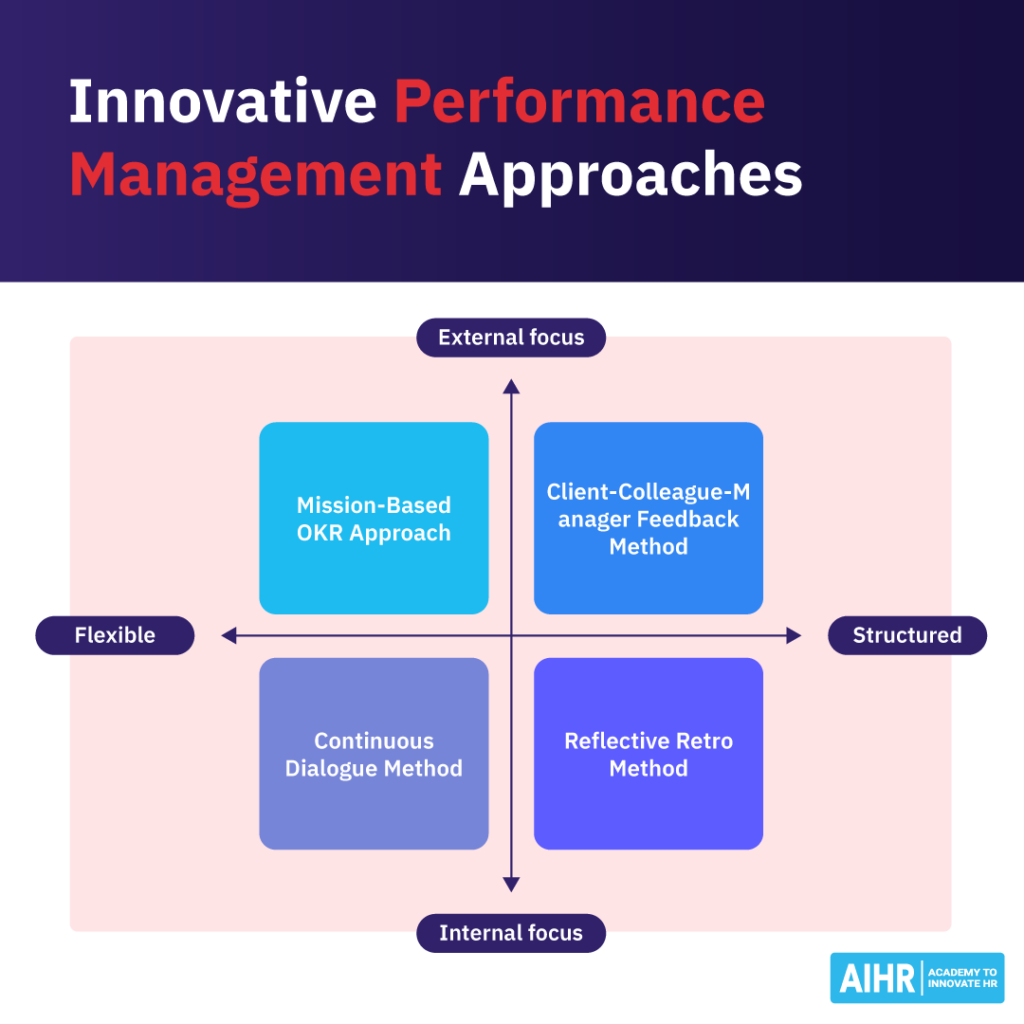
1. The Retro Reflection Method
The Retro Reflection Method centers on continuous feedback and focuses on collaboration and behavior. It’s ideal for project-based or assignment-driven work, where clear goals are set at the outset and reviewed at the end of each project or cycle.
How it works:
- Step 1: Target impact statement: At the beginning of a project or assignment, the employee and their manager collaboratively craft a target impact statement. This statement clearly defines the work, success criteria, and expected impact. For example, if an employee is developing a new product feature, the statement would outline specific tasks, what success looks like, and how the feature will impact the business.
- Step 2: Retro reflection conversation: After the work is completed, the employee and manager meet to discuss the outcomes. Both parties reflect on successes, missed opportunities, and areas for improvement. Questions like “What could I have done differently?” and “Did I meet the impact targets?” guide the conversation.
- Step 3: Finalize reflections: After the conversation, the employee documents feedback and their own reflections. This creates a portfolio of evidence over time, which can be reviewed during formal performance evaluations.
When to use: The Retro Reflection Method is ideal for project-driven environments where employees move between teams or work on short- to medium-term assignments. It’s particularly effective for agile organizations or those with a heavy emphasis on team collaboration.
Example of the target impact statement
Anaya is a visual designer for an eLearning company. She is developing an online course to support the adoption of a new payment system.
A good target impact statement is made of four parts:
- A description of the work
- The activities that need to be completed
- What success looks like
- And how this work will have an impact.
Her impact statement could be something like this:
- I am working on a project to build a new online course.
- I oversee all visual content design, development, and quality assurance.
- I will know I am successful if all visual content is well-designed, delivered on time, and requires minimal rework.
- My impact achievement will be substantiated through feedback from the business that the learning has enabled their teams to adopt the new payment system successfully.
She started by describing the work and then spoke about his role and the activities he would engage in. She then defined success and concluded by describing the impact that his work would achieve.
The target impact statement helps to clarify work and creates a shared understanding of what success looks like for this initiative between Anaya and her project manager.
2. Client-Colleague-Manager Feedback Method
The Client-Colleague-Manager Feedback Method is designed to capture feedback from multiple perspectives, ensuring a holistic view of employee performance. It’s especially useful in client-facing roles where external relationships and service delivery are key performance indicators.
This method is similar to traditional 360-degree feedback, yet it differs in two important ways. First, the feedback frequency is higher for this method, focusing on asking shorter, more targeted questions more frequently. Second, the emphasis in this method is largely on the external client, and their feedback will be weighed higher than that of internal stakeholders.
How it works:
- Step 1: Define feedback criteria: The employee and manager establish criteria for evaluating performance. These might include service quality, client satisfaction, and collaboration with colleagues. Each criterion is broken down into clear questions for feedback collection, such as “Did I meet your expectations?” or “What could I have done better?”
- Step 2: Identify key stakeholders: Feedback is gathered from a balanced mix of clients, colleagues, and managers. The employee selects stakeholders who have observed their work, ensuring that the feedback is comprehensive and unbiased.
- Step 3: Collect and analyze feedback: Feedback is clustered into themes, highlighting strengths, areas for improvement, and any surprises or blind spots. These insights are then reviewed in preparation for a feedback conversation.
- Step 4: Discuss and reflect: The final step involves a structured discussion between the employee and manager, focusing on the feedback themes and identifying development opportunities.
Client-Colleague-Manager Feedback Method scenario
Mira, a project manager, is preparing for her mid-year review with her manager, Tom. They establish criteria such as service quality, client satisfaction, and collaboration and create clear questions for feedback, such as “Did I meet your expectations in delivering project milestones?” Mira selects key clients, colleagues, and Tom to ensure comprehensive feedback from those who have observed her work.
Feedback is gathered and grouped into themes:
- Strengths (e.g., client relationship management)
- Areas for improvement (e.g., time management during busy periods)
- Any unexpected feedback (e.g., a colleague mentioned her handling of conflict in team meetings).
In the review meeting, Mira and Tom discuss feedback themes, celebrate successes, and identify development opportunities, such as improving time management and conflict resolution skills.
When to use:
This method is ideal for service-oriented roles or environments where employees frequently collaborate with both internal and external stakeholders. It works well for organizations that value client feedback as a key measure of performance.
We discussed how organizations can innovate their performance management for business impact with Megan Bickle, Fractional Talent Management Strategist and performance management expert. Watch the full interview below:
3. Mission-Based OKR Method
The Mission-Based OKR (Objectives and Key Results) Method focuses on aligning individual and team objectives with broader organizational goals. This approach encourages flexibility and regular feedback, ensuring continuous alignment with the company’s mission.
How it works:
- Step 1: Set OKRs (Objectives and Key Results): Leadership sets high-level objectives for the organization or department, supported by measurable key results. These objectives are ambitious, focusing on key priorities that drive the business forward.
- Step 2: Teams define missions: Each team identifies specific missions that contribute to the overall objectives. For example, a marketing team might focus on increasing brand engagement, while a product team works on feature enhancements that support customer retention.
- Step 3: Align and adjust: Missions are regularly reviewed and adjusted based on progress and changing priorities. Teams collaborate to ensure their efforts align with the overall objectives and key results.
- Step 4: Feedback and reflection: At the end of the performance cycle, teams review their progress toward the key results, discussing what went well, what didn’t, and what could be improved for future missions.
Mission-Based OKR Method scenario
Leadership sets a high-level objective to increase online sales by 20%, with key results including improving website user experience and launching new digital marketing campaigns. The digital marketing team focuses on boosting customer engagement through targeted ads, while the IT team works on optimizing the website for faster load times and better navigation.
Midway through the quarter, both teams review their progress. The marketing team adjusts its strategy to include social media influencers, while the IT team shifts focus to address unexpected website bugs. At the quarter’s end, teams reflect on their results. Marketing hit its engagement targets, but IT encountered delays. They discuss what worked, identify obstacles, and plan for more efficient execution in the next cycle.
When to use:
This method is highly effective in fast-paced, growth-oriented organizations with constantly evolving objectives. It’s also ideal for organizations that value agility and flexibility in their performance management processes.
4. Continuous Dialogue Method
The Continuous Dialogue Method emphasizes ongoing conversations between employees and managers. Rather than focusing on specific goals, this method centers around behavior and contributions to team success.
How it works:
- Step 1: Hold regular conversations: Employees meet with their managers regularly to discuss their performance. During these conversations, the employee answers five key questions posed by the manager: “Where am I making the biggest impact?” “Where am I missing opportunities?” “How am I supporting the team?” “Where am I a stumbling block?” “What’s one thing I could change?”
- Step 2: Focus on behaviors: The conversations emphasize behaviors and how they contribute to the team’s and organization’s success, encouraging continuous improvement and self-reflection.
- Step 3: Conduct no formal review: This method does not involve formal performance reviews. Instead, it emphasizes regular, informal check-ins that promote growth and development.
Continuous Dialogue Method scenario
Every month, Paul, a senior consultant, has an informal check-in with his manager, Delia. During these meetings, Delia asks specific questions to guide their conversation, leading to discussions about how Paul’s collaborative approach has strengthened the team’s project delivery. However, Delia noted that he sometimes dominates discussions, which might discourage input from quieter team members.
Together, they explored how Paul could adjust his communication style to be more inclusive. By focusing on specific behaviors like communication and leadership in monthly informal check-ins, Delia helps Paul continuously improve his contributions to the team throughout the year.
When to use:
This method is well-suited to mature organizations with a culture of open feedback and collaboration. It works particularly well for senior employees or environments that prioritize continuous improvement over rigid performance metrics.
How to start innovating your performance management
If you’re ready to shift away from traditional performance management and explore these alternative methods, here’s how to begin:
- Assess organizational needs: Determine which method aligns best with your company’s structure, culture, and goals. Do you need a more structured approach, or would a flexible method work better?
- Pilot a method: Start with a small pilot group to test the selected method. Collect feedback and make adjustments as needed before rolling it out company-wide.
- Train managers: Ensure managers have the skills to implement the new method effectively, particularly when it comes to giving feedback and facilitating discussions.
- Create a feedback loop: Establish a system for gathering feedback on the performance management process, allowing continuous refinement and improvement.
According to Megan Bickle, the priority is ensuring that employees have regular conversations with their leaders so they’re always clear on their current priorities and how well they’re performing. Bickle emphasizes the importance of simplicity in performance management. “I would hope that every single employee feels like they know what’s expected of them and that they’re talking to their leader,” she says.
Whether through one-on-one meetings or goal check-ins, as long as these conversations are happening in a way that works for the team, the specifics of how they’re done are less important from an organizational perspective.
Performance management remains a crucial process for business success, but you need to find the right approach that fits the context and realities of your business.
Learn more
Related articles
Are you ready for the future of HR?
Learn modern and relevant HR skills, online







